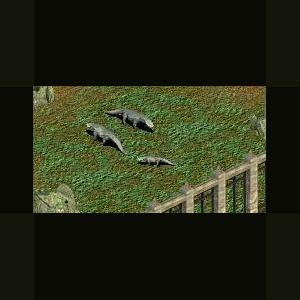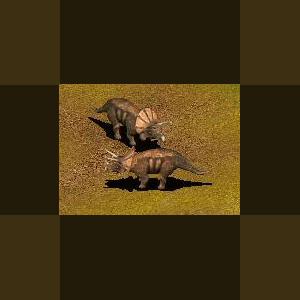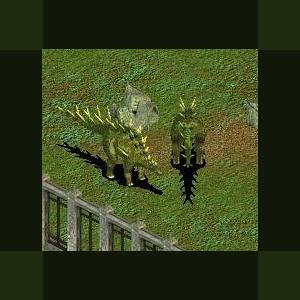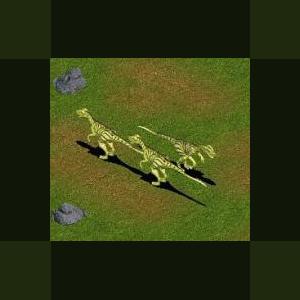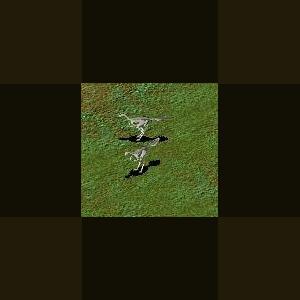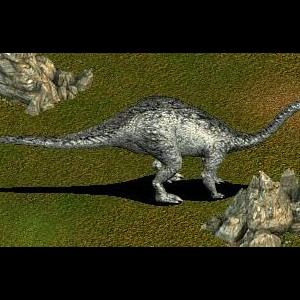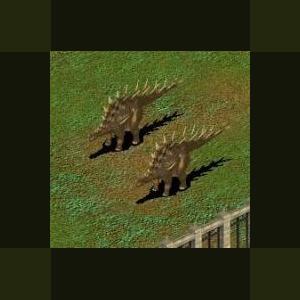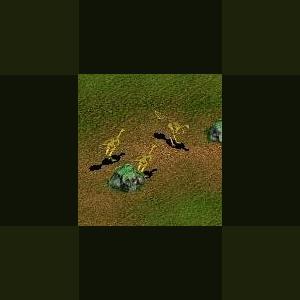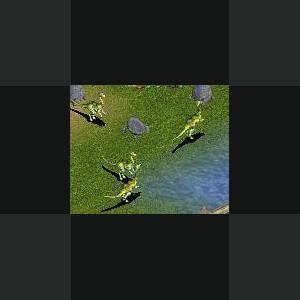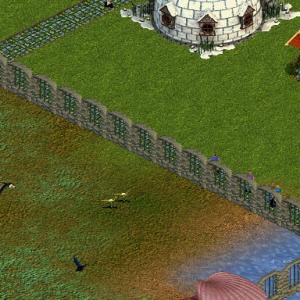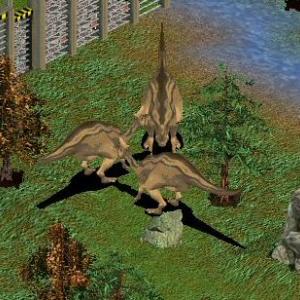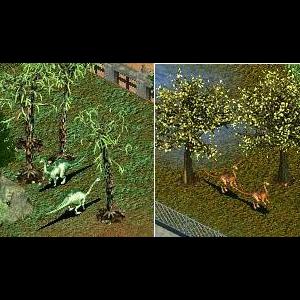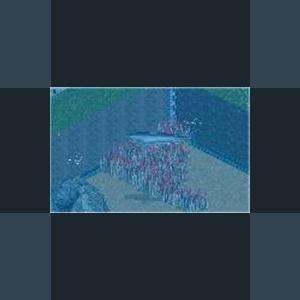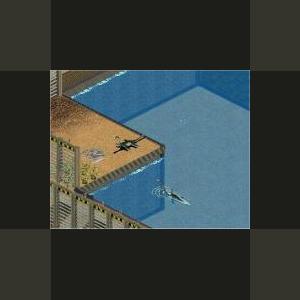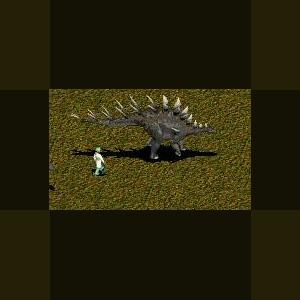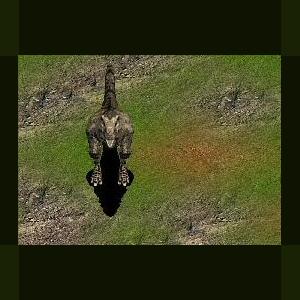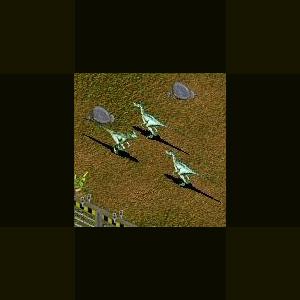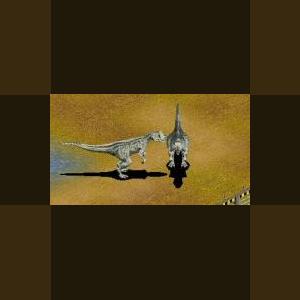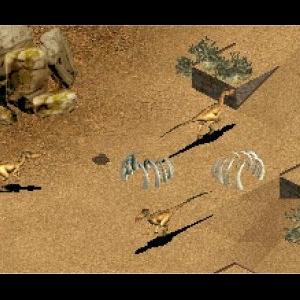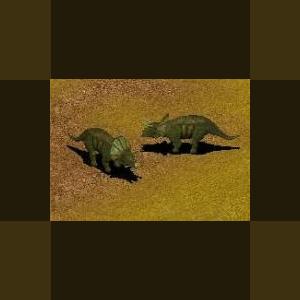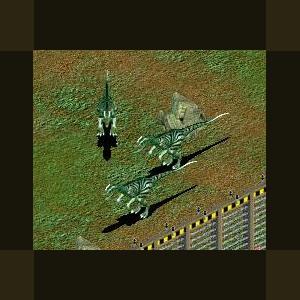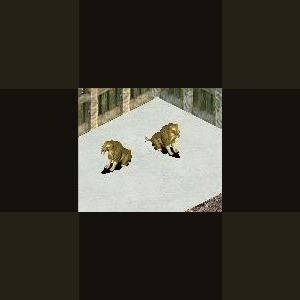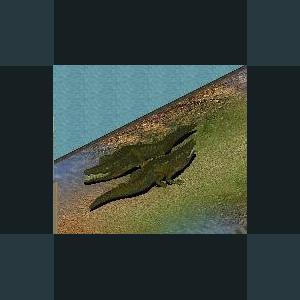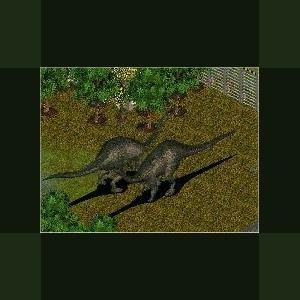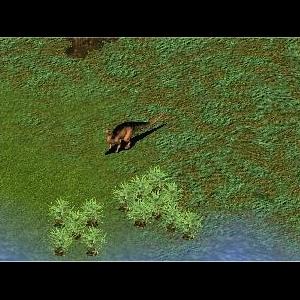Dinosaurs
Creatures from another age
241 files
-
Chasmatosaurus by Moondawg
By Guest
Chasmatosaurus is an extinct genus of archosauriform reptile that grew about 4 m (12 ft 8 in) long from the Early Triassic of China.
Also called Proterosuchus, Chasmatosaurus was a crocodile-like creature that probably hunted like its extant descendants, attacking drinking prey on the waterside. Its upper jaw arched down at the front, and the creature had teeth on its palate- a primitive trait. it had a main cameo in walking with monsters attacking a herd of lystrosaurus. it is a possibility that chasmatosaurus is an ancestor of crocodillians.
228 downloads
0 comments
Updated
-
Chasmosaurus by Moondawg
By Guest
Chasmosaurus (KAZ-mo-sawr-us) is a ceratopsid dinosaur genus from the Upper Cretaceous Period of North America.
Ceratopsians are split into two subfamilies by taxonomists; those with short frills
(centrosaurines), such as Centrosaurus and those with long frills (chasmosaurines), of
which Chasmosaurus was one. In addition to the larger frill, the long-frilled ceratopsians
typically had longer faces and jaws and it is suggested by some paleontologists that they
were more selective about the plants they ate. Long frills were a relatively late
development in dinosaur evolution, since even Chasmosaurus dates from the late Cretaceous
Period, 76 to 70 million years ago. The frill of Chasmosaurus has been described as
"heart-shaped", since its bone structure consists of two large 'loops' from a central bone.
Some finds include a number of smaller ossifications (called epoccipitals), which may have
grown from the perimeter of the frill. The frill may also have been brightly colored, to
draw attention to its size or as part of mating display. However, the frill was so large
and yet so flimsy (since it was mainly skin stretched between the bones) that it could not
have provided much functional defense. It is possible that it was simply used to appear
imposing or conceivably for thermoregulation. In the event of a chasmosaur herd being
attacked by a predator (such as Tyrannosaurus), the males could have formed a ring and,
with all the frills facing outwards, would have presented a formidable sight.
A drawing of Chasmosaurus.Like many ceratopsians, chasmosaurs had three main facial horns - one on the nose and two on the brow. Different fossil finds have produced inconclusive
results - one species of Chasmosaurus, named C. kaiseni, bore long brow horns, while C. belli had only short ones. Although these were initially named as different species, it now seems possible that the long horns belonged to males and the shorter horns to females.
Interestingly, a Chasmosaurus specimen recovered by Sternberg was accompanied by
fossilized skin.The skin appears to have had many bony knobs (osteoderms) in evenly spaced rows, with five or six sides per knob. Unfortunately, nothing can be learned about the coloration of Chasmosaurus from the known fossil skin samples.
Inspired by the Zoo Tek Brains Trust
238 downloads
Updated
-
Chialingosaurus by Moondawg
By Guest
Chialingosaurus (meaning "Chialing Lizard") was a type of stegosaur similar to Kentrosaurus from the Upper Shaximiao Formation, Late Jurassic beds in Sichuan Province in China.
Its age makes it one of the oldest species of stegosaurs, living about 160 million years ago. Since it was an herbivore, scientists think that Chialingosaurus probably ate ferns and cycads, which were plentiful during the period when Chialingosaurus was alive. Its name is taken from the Chialing River in southern China. Perhaps growing up to 13 ft (4m) long and weighing just 330 pounds (150 Kg), much less than other later stegosaurs.
Collected by the geologist Kuan in 1957 in Quxian County, the dinosaur was named by paleontologist C. C. Young two years later, although only very incomplete fossilized remains of Chialingosaurus have been found, and those fossil remains belong to a juvenile. In 1969, Rodney Steel suggested that Chialingosaurus might have actually been an early ancestor of other stegosaurs, but it is difficult to tell: the type specimen, Chialingosaurus kuani is known from only one partial skeleton, the original material having been supplemented in 1978 by Zhou of the Municipal Museum of Chongqing.
234 downloads
0 comments
Updated
-
Chindesaurus by Moondawg
By Guest
Chindesaurus (CHIN-dee-SAWR-us - Chinde (Navajo, chiindii) meaning "ghost or evil spirit" and Greek sauros meaning "lizard") is a genus of theropod dinosaur named after the Chinde Point.
Chindesaurus was a basal theropod which lived around 225 million years ago during the Late Triassic. It was between 6 and 12 feet (3.7 m) long, and was formally described by Long and Murry in 1995. The type species, Chindesaurus bryansmalli, is named in honor of the discoverer.
183 downloads
0 comments
Updated
-
Chirostenotes by Moondawg
By Guest
Chirostenotes
Chirostenotes (pronounced KIE-ro-STEN-o-teez, named from Greek 'narrow-handed') was an oviraptorosaur from the late Cretaceous (80 million years ago) of Alberta, Canada.
It was characterized by a beak, long arms ending in powerful claws, long, slender toes and a tall, rounded cassowary-like crest or casque. Chirostenotes was probably an omnivore or herbivore, although the beak is not as heavily constructed as in the Asian Oviraptoridae. The type species is Chirostenotes pergracilis. A smaller species, C. elegans, has also been named from Alberta,[1] although it probably belongs to the closely-related Elmisaurus.[2] A large skeleton from the Horseshoe Canyon Formation has been referred to Chirostenotes pergracilis, although it may represent a new species. The first Chirostenotes was found in the Dinosaur Park Formation of Canada, which has yielded the most dinosaurs of any Canadian formation.
In life, the animal was about 9.5 feet (2.9 m) long and 3 feet (0.91 m) tall at the hips. It had an estimated weight of about 110 pounds. It probably ate small reptiles and mammals, as well as plants, eggs and insects.
This dinosaur has a confusing history. It was given its first name, Chirostenotes, when a pair of hands was found in 1924. The feet were then found, in 1932 and given the name Macrophalangia, meaning 'large toes'. Later, they were correctly recognized as part of a meat-eating dinosaur but no-one was sure if they were from the same species. In 1936, its jaws were found and given the name Caenagnathus, meaning 'recent jaw' (the family of oviraptorosaurs containing Chirostenotes, the Caenagnathidae, still carries this name); they were first thought to be those of a bird. In 1988, a specimen from storage since 1923 was discovered and studied. This fossil helped link the other discoveries into a single dinosaur. Since the first name applied to any of these remains was Chirostenotes, this is the only name that is recognized as valid.
Also, a set of jaws with strange teeth were originally thought to be part of Chirostenotes but, now that it is known that Chirostenotes was a toothless oviraptorosaur, the jaws have been renamed Ricardoestesia and are from an otherwise unknown dinosaur.
176 downloads
0 comments
Updated
-
Chubutisaurus by Moondawg
By Guest
Chubutisaurus was a species of dinosaur from the Early Cretaceous Period.
It lived in South America. It is classified as a Sauropod, specifically one of the titanosaurs. The type species, C. insignis, was described by del Corro in 1975.
156 downloads
0 comments
Updated
-
Chungkingosaurus by Moondawg
By Guest
Chungkingosaurus, meaning "Chongqing Lizard", was a genus of dinosaur from the Late Jurassic from the Upper Shaximiao Formation in what is now China. It is classified as a Stegosaurid.
The type species, Chungkingosaurus jiangbeiensis, was found near Chongqing, China. in 1977 and described by Dong Zhiming, Zhou Shiwu, and Chang Yihong in 1983. There were many stegosaurs found in China in 1977 (the year Chungkingosaurus was found), but Chungkingosaurus was the smallest of these.
One of the smallest of the family at 3-4 metres long (10-13 ft), Chungkingosaurus had at least five spikes on its thagomizer. It had a rather high and narrow skull and large, thick bony plates. Like all stegosaurs, it was a herbivore. Chungkingosaurus had spiny plates on its back, which were arranged in pairs, but the total number is unknown. A specimen in the Chongqing Municipal museum is represented as having 14 pairs of plates. This specimen also had two pairs of tail spikes.
Chungkingosaurus is thought to have coexisted with large plant-eaters and stegosaurids such as Chialingosaurus, Tuojiangosaurus, Mamenchisaurus, and Omeisaurus. It may have also faced being a meal of predators such as the theropods Yangchuanosaurus and Szechuanosaurus.
199 downloads
0 comments
Updated
-
Citipati by Moondawg
By Guest
Citipati (Sanskrit for 'funeral pyre lord') is a genus of oviraptorid theropod dinosaur from the Late Cretaceous Period of what is now Mongolia.
It is one of the best-known oviraptorids, thanks to a number of well-preserved skeletons, including several specimens found in brooding positions atop nests of eggs. These nesting specimens have helped to solidify the link between non-avian dinosaurs and birds.
The type species, Citipati osmolskae, was described by James M. Clark, Mark Norell, and Rinchen Barsbold in 2001. A second, as yet unnamed species may also exist. Citipati is often confused with the similar Oviraptor.
The largest Citipati were emu-sized animals and, at about 3 meters (9 ft) long, were the largest oviraptorids until Gigantoraptor was described in 2007. Like other oviraptorids, Citipati had an unusually long neck and shortened tail, compared to most other theropods. Its skull was unusually short and highly pneumatized (riddled with openings in the bone structure), ending in a stout, toothless beak. Perhaps the most distinctive feature of Citipati was its tall crest, superficially similar to that of a modern cassowary. The crest was relatively low in the type species, C. osmolskae, and taller, with a pointed tip, in a referred specimen which has not yet been assigned a specific name (provisionally labelled C. sp.).
171 downloads
0 comments
Updated
-
Compsognathus by Moondawg
By Guest
Compsognathus (pronounced kompsos"elegant", "refined" or "dainty", and gnathos"jaw") was a small, bipedal, carnivorous theropod dinosaur.
The animal was the size of a turkey and lived around 150 million years ago, the early Tithonian stage of the late Jurassic Period, in what is now Europe.
Paleontologists have found two well-preserved fossils, one in Germany in the 1850s and the second in France more than a century later.
Many popular presentations still describe Compsognathus as a "chicken-sized" dinosaur because of the small size of the German specimen, which is now believed to be a juvenile form of the larger French specimen. Compsognathus is one of the few dinosaurs for which the diet is known with certainty: the remains of small, agile lizards are preserved in the bellies of both specimens. Teeth discovered in Portugal may be further fossil remains of the genus.
Although not recognized as such at the time of its discovery, Compsognathus is the first dinosaur known from a reasonably complete skeleton. Today, C. longipes is the only recognized species, although the larger specimen discovered in France in the 1970s was once thought to belong to a separate species, C. corallestris. Until the 1980s and 1990s, Compsognathus was the smallest known dinosaur and the closest supposed relative of the early bird Archaeopteryx. Thus, the genus is one of the few dinosaur genera to be well known outside of paleontological circles.
273 downloads
0 comments
Updated
-
0 comments
Updated
-
Corythosaurus by Moondawg
By Guest
Corythosaurus
Corythosaurus meaning 'helmet lizard' because of the shape of its crest (Greek korythos meaning 'helmet' and sauros meaning 'lizard') was a genus of duck-billed dinosaur from the Upper Cretaceous Period, about 80 million years ago. It lived in what is now North America.
The first specimen was discovered in 1912 by Barnum Brown in Red Deer River, Alberta, Canada. As well as an almost complete skeleton, the find was remarkable because much of the creature's fossilized skin had also survived. In 1916, the Canadian (Canadian Pacific Lines) ship Mount Temple was carrying two specimens and other fossils from today's Dinosaur Provincial Park, Alberta, Canada to Britain. It was sunk by the German surface raider SMS Moewe, sending its 75 million year old cargo to the bottom of the North Atlantic, where it rests to this day.
There were originally up to seven species described including C. casaurius, C. bicristatus, C. brevicristatus, C. excavatus, C. frontalis, and C. intermedius. In 1975 Peter Dodson studied the differences between the skulls and crests of different species of lambeosaurine dinosaurs. He found that the differences in size and shape may have actually been related to the gender and age of the animal. Now only one species is recognized, C. casuarius.
Corythosaurus is classified as a hadrosaurid, in the subfamily Lambeosaurinae. It is related to other hadrosaurs such as Hypacrosaurus, Lambeosaurus and Olorotitan, with the exception of Olorotitan they all share similar looking skulls and crests. However, recent research has suggested that Olorotitan is Corythosaurus closest known relative even though it doesn't share as many skull characteristics as other lambeosaurs.
Corythosaurus weighed in at 4 tonnes and measured roughly 10 metres (35 ft) from nose to tail. Like other hadrosaurs it had a toothless beak, the back of the jaws contained a dental battery composed of hundreds of small, interlocking teeth. These were used to crush and grind plant matter and were continually replaced as they wore away.
Over 20 skulls have been found from this dinosaur. As with other lambeosaurs, the animal bore a tall, elaborate bony crest atop its skull, which contained the elongate nasal passages. The nasal passages extended into the crest, first into separate pockets in the sides, then into a single central chamber and onward into the respiratory system.
Any vocalization would travel through these elaborate chambers, and probably get amplified. Scientists speculate that Corythosaurus could make loud, low pitched cries "Like a wind or brass instrument." The sounds could serve to alert other Corythosaurus to the presence of food or a potential threat from a predator.
It was once thought that this dinosaur lived mostly in the water, due to the appearance of webbed hands and feet. However, it was later discovered that the so-called "webs" were in fact deflated padding, much like that found on many modern mammals.
317 downloads
0 comments
Updated
-
Cranky Cretaceous by Jeff
By Guest
Saltasaurus and Struthiomimus
Two wonderful dinosaurs originally released at JBL's (Jeff) old site Zooty ZT.
Struthiomimus is an omnivore, small and fast.
Saltasaurus is an herbivore.
Updated by fern and Jay Sept 2008 to add English translations done by Dizzy (thank you), making the sounds more efficient, and removing some unnecessary files.
Requires LANG--JBL.dll by fern from hacks and Utilities
(File info update 22 Nov 08)
283 downloads
0 comments
Updated
-
Cretoxyrhina by Ghirin
By Guest
Cretoxyrhina mantelli
Author Ghirin
The genus Cretoxyrhina was a member of the lamniform sharks from the late Cretaceous period. Its remains, mainly teeth, have been found worldwide. A large species, C. mantelli, has been found in what was the interior seaway of North America. It was similar in size to the modern great, white shark, but was not a close relative.
Like the modern great white shark, C. mantelli was an apex predator, feeding on marine reptiles such as moasaurs. The shark was nicknamed Ginsu due to the damage inflicted on its prey
394 downloads
0 comments
Updated
-
Cryptocleidus by Ghirin
By Guest
Cryptocleidus Author: Ghirin
Cryptocleidus ("Hidden Collar Bone") was a genus of plesiosaur from the late Jurassic period. Its fossils were found in Europe.
*Inspired by the Zoo Tycoon Brains Trust at the Zoo Tek Evolved Forums.
289 downloads
0 comments
Updated
-
Dacentrurus by Moondawg
By Guest
Dacentrurus ("very sharp tail"), originally known as Omosaurus, was a large stegosaur of the late Jurassic Period (154 - 150 mya).
This dinosaur measured around 6 - 10 m (20 - 33 ft) in length.
When it was described by Richard Owen in 1875 as Omosaurus armatus, it was the first stegosaur ever discovered, although the genus name had to be changed as the name Omosaurus was preoccupied.
Fossil evidence has been found in Wiltshire and Dorset (including a vertebra ascribed to D. armatus in Weymouth[1]) in southern England, France and Spain and five more historically recent skeletons from Portugal. It had paired triangular plates down its spine, with four pairs of spikes on the end of the tail. This configuration closely resembles that of its relative, Kentrosaurus (see also: thagomizer). For unknown reasons, many books claim that Dacentrurus was a small stegosaur, when in fact finds such as a 1.5 m pelvis (measured at the acetabula) suggest that Dacentrurus was among the largest of them.
Other claimed species of Dacentrurus include D. durobrivensis (included with Lexovisaurus durobrivensis), D. phillipsi (sometimes mistakenly included with Priodontognathus phillipsi, due to having the same species name and a confused history), and D. vetustus (included with Lexovisaurus vetustus).
259 downloads
0 comments
Updated
-
Daspletosaurus by Moondawg
By Guest
Daspletosaurus is closely related to the much larger and more recent Tyrannosaurus. Like most known tyrannosaurids, it was a multi-ton bipedal predator equipped with dozens of large, sharp teeth. Daspletosaurus had the small forelimbs typical of tyrannosaurids, although they were proportionately longer than in other genera.
As an apex predator, Daspletosaurus was at the top of the food chain, probably preying on large dinosaurs like the ceratopsid Centrosaurus and the hadrosaur Hypacrosaurus. In some areas, Daspletosaurus coexisted with another tyrannosaurid, Gorgosaurus, though there is some evidence of niche differentiation between the two. While Daspletosaurus fossils are rarer than other tyrannosaurids, the available specimens allow some analysis of the biology of these animals, including social behavior, diet and life history.
While very large by the standard of modern predators, Daspletosaurus was not the largest tyrannosaurid. Adults could reach a length of 8–9 meters (26–30 ft) from snout to tail. Mass estimates have centered around 2.5 tonnes (2.75 short tons)but have ranged between 1.8 tonnes (2 tons)and 3.8 tonnes (4.1 tons).
Life restoration of Daspletosaurus. Daspletosaurus had a massive skull that could reach more than 1 meter (3.3 ft) in length. The bones were heavily constructed and some, including the nasal bones on top of the snout, were fused for strength. Large fenestrae (openings) in the skull reduced its weight. An adult Daspletosaurus was armed with about six dozen teeth that were very long but oval in cross section rather than blade-like. Unlike its other teeth, those in the premaxilla at the end of the upper jaw had a D-shaped cross section, an example of heterodonty always seen in tyrannosaurids. Unique skull features included the rough outer surface of the maxilla (upper jaw bone) and the pronounced crests around the eyes on the lacrimal, postorbital, and jugal bones. The orbit (eye socket) was a tall oval, somewhere in between the circular shape seen in Gorgosaurus and the 'keyhole' shape of Tyrannosaurus.
Daspletosaurus shared the same body form as other tyrannosaurids, with a short, S-shaped neck supporting the massive skull. It walked on its two thick hindlimbs, which ended in four-toed feet, although the first digit (the hallux) did not contact the ground. In contrast, the forelimbs were extremely small and bore only two digits, although Daspletosaurus had the longest forelimbs in proportion to body size of any tyrannosaurid. A long, heavy tail served as a counterweight to the head and torso, with the center of gravity over the hips.
242 downloads
0 comments
Updated
-
Deinonychus by Moondawg
By Guest
This 3.4 metre (11 ft) long dinosaur lived during the early Cretaceous Period (Aptian - Albian stages, 121 to 98.9 million years ago). Fossils of the only named species (D. antirrhopus) have been recovered from the U.S. states of Montana, Wyoming and Oklahoma, though teeth that may belong to Deinonychus have been found much farther east in Maryland.
(Terrible claw) refers to the unusually large, sickle-shaped talon on the second toe of each hind foot, which was probably held up off the ground while the dinosaur walked on the third and fourth toes. It was commonly thought that Deinonychus would kick with the sickle claw to slash at its prey but recent tests on reconstructions of similar Velociraptor talons suggest that the claw was used to stab, not slash. The species name antirrhopus means (counter balance), which refers to John Ostrom's idea about the function of the tail. As in other dromaeosaurids, the tail vertebrae have a series of ossified tendons and super - elongated bone processes. These features seemed to make the tail into a stiff counterbalance, but a fossil of the very closely related Velociraptor mongoliensis has an articulated tail skeleton that is curved laterally in a long S – shape. This suggests that, in life, the tail could swish to the sides with a high degree of flexibility In both the Cloverly and Antlers Formation, Deinonychus remains have been found closely associated with those of the ornithopod Tenontosaurus. Teeth discovered associated with Tenontosaurus specimens imply it was hunted or at least scavenged upon by Deinonychus.
Paleontologist John Ostrom's study of Deinonychus in the late 1960s revolutionized the way scientists thought about dinosaurs, igniting the debate on whether or not dinosaurs were warm-blooded. Before this, the popular conception of dinosaurs had been one of plodding, reptilian giants. Ostrom noted lightweight bones and raptorial claws on the feet, which revealed an active, agile predator.
342 downloads
0 comments
Updated
-
Deltadromeus by Moondawg
By Guest
Deltadromeus ("delta runner") is a genus of theropod dinosaur from Northern Africa. This carnivore had long, unusually slender hind limbs for its size, suggesting that it was a swift runner.
It lived in the late Cretaceous Period, about 95 million years ago. It may have been one of the longest carnivorous dinosaurs, with one unpublished survey indicating that a referred partial specimen could represent an individual that was around 13.3 meters (44 ft) long, though it would have weighed only an estimated 3.5 tons, making it more slender than the giant carnosaurs. The more complete holotype specimen measured an estimated 8.1 m (26.5 ft) long. Deltadromeus skeletons have been found with those of the carnosaur Carcharodontosaurus, and it may have lived along side the even larger Spinosaurus. The specific name D. agilis, meaning "swift delta runner", comes from the fact that this species had adaptations for running, and that its remains were found in a fossilized river delta. Deltadromeus was originally described as a large coelurosaur, but more recent studies suggest it was actually a ceratosaur, possibly a gigantic member of the noasaurid family.
218 downloads
0 comments
Updated
-
Desert Velociraptor by Ghirin
By Guest
Desert Velociraptor
Author: Ghirin
During the late Cretaceous Period, the area now known as the Gobi Desert had a semi-arid climate. The fossils of many species of dinosaurs have been found there, such as Protoceratops, Oviraptor, and Velociraptor.
Velociraptor was a fierce predator that might have lived in hunting packs. A fossil of a Velociraptor and a Protoceratops locked in battle indicates that this therapod was a predator of Protoceratops.
Reference:
Encyclopedia of Dinosaurs and Other Prehistoric Creatures. Malam and Parker, 2003
Created by Ghirin 2004
440 downloads
0 comments
Updated
-
Diceratus by Moondawg
By Guest
Diceratus (meaning "two-horned") is a ceratopsid herbivorous dinosaur genus from the Late Cretaceous period of North America. It is known only from a single poorly preserved skull discovered in Wyoming and described in 1905 as Diceratops.
For many years, it had been considered a species within the genus Triceratops, but recent analysis (Forster, 1996) suggests it is a distinct genus. Since the Diceratops name was preoccupied, it was renamed to Diceratus in 2008.
Diceratus was first described as Diceratops ("two horned face"), but it was found that the name was already in use for a hymenopteran (Foerster, 1868). It was given its current name by Octávio Mateus in 2008.
The paper that described Diceratus was originally part of O. C. Marsh's magnum opus, his Ceratopsidae monograph. Unfortunately, Marsh died (1899) before the work was completed, and John Bell Hatcher endeavored to complete the Triceratops section. However, he died of typhus in 1904 at the age of 42, leaving the paper still uncompleted. It fell to Richard Swann Lull to complete the monograph in 1905, publishing Hatcher's description of a skull separately and giving it the name Diceratops hatcheri.
Since the Diceratops paper had been written by Hatcher, and Lull had only contributed the name and published the paper after Hatcher's death, Lull was not quite as convinced of the distinctiveness of Diceratops, thinking it primarily pathological. By 1933, Lull had had second thoughts about Diceratops being a distinct genus and he put it in a subgenus of Triceratops: Triceratops (Diceratops), including T. obtusus; largely attributing its differences to being that of an aged individual.
199 downloads
0 comments
Updated
-
Dilophosaurus by Moondawg
By Guest
Dilophosaurus
Dilophosaurus was a theropod dinosaur from the Early Jurassic Period. The name is pronounced ("dy-LOH-fo-sawr-us") meaning 'two-crested lizard', because it had two crests (Greek di meaning 'two', lophos meaning 'crest' and sauros meaning 'lizard')
Dilophosaurus measured around six meters (20 ft) long and may have weighed half a ton.
The most distinctive characteristic of Dilophosaurus is the pair of rounded crests on its skull, possibly used for display. Studies by Robert Gay show no indication that sexual dimorphism was present in the skeleton of Dilophosaurus, but says nothing about crest variation. The teeth of Dilophosaurus are long, but have a fairly small base and expand basally. Another skull feature was a notch behind the first row of teeth, giving Dilophosaurus an almost crocodile-like appearance, similar to the putatively piscivorous spinosaurid dinosaurs. This "notch" existed by virtue of a weak connection between the premaxillary and maxillary bones of the skull. This conformation led to the early hypothesis that Dilophosaurus scavenged off dead carcasses, with the front teeth being too weak to bring down and hold large prey.
The first Dilophosaurus specimens were discovered by Sam Welles in the summer of 1942. The specimen was brought back to Berkeley for cleaning and mounting, where it was given the name Megalosaurus wetherilli. Returning to the same formation a decade later to determine from which time period the bones dated, Welles found a new specimen not far from the location of the previous discovery. The specimens were later renamed Dilophosaurus, based on the double crest clearly visible in the new skeleton.
There is another species of Dilophosaurus (D. sinensis), which may or may not belong to this genus. It is possibly closer to the bizarre Antarctic theropod Cryolophosaurus, based on the fact that the anterior end of the jugal does not participate in the internal antorbital fenestra and that the maxillary tooth row is completely in front of the orbit and ends anterior to the vertical strut of the lacrimal. This species was recovered from the Yunnan Province of China in 1987, with the prosauropod Yunnanosaurus and later described and named in 1993 by Shaojin Hu.
A third species, D. breedorum, was coined by Samuel Welles through Welles and Pickering (1999). This species was based upon crested specimen UCMP 77270. Welles' original material lacked well-preserved crests, and he suggested that the crested specimens pertained to a different species. He was unable to complete a manuscript describing this during his lifetime, and the name eventually came out in a private publication distributed by Pickering. This species has not been accepted as valid in other reviews of the genus.
Dilophosaurus was prominently featured both in the 1993 movie Jurassic Park and in the original novel by Michael Crichton. In the film version, Dilophosaurus has a retractable neck frill around its neck (much like a frill-necked lizard), and spits blinding poison, aiming for the eyes to blind and paralyze its prey (much like a spitting cobra). There is no evidence to support either the frill or the venom spitting, which was acknowledged by Crichton as creative license.In the film, Steven Spielberg also reduced the size of Dilophosaurus to 3 feet (0.91 m) tall and 5 feet (1.5 m) long, much smaller than it was in reality. Jurassic Park merchandise, including toys and video games (such as Jurassic Park: Operation Genesis and the arcade games The Lost World: Jurassic Park and Jurassic Park III), often include Dilophosaurus.
Despite its inaccuracies, the Jurassic Park Dilophosaurus has been taken up by others. Several other video games, such as ParaWorld and Jurassic Wars, and Ice Age: Dawn of the Dinosaurs feature Dilophosaurus modeled after the representations in Jurassic Park, and The Whitest Kids U'Know sketch "Dinosaur Rap", a music video for Trevor Moore's "Gettin' High With Dinosaurs" features a Dilophosaurus, complete with a short frill. One video game, 2008's Turok, features Dilophosaurus based more closely on real fossils and displays their correct size. Dilophosaurus was also featured in the documentary When Dinosaurs Roamed America, killing an Anchisaurus and scaring off a pack of Syntarsus (now known as Megapnosaurus).
http://en.wikipedia.org/wiki/Dilophosaurus
491 downloads
0 comments
Updated
-
Dinictus by Moondawg
By Guest
Dinictis was a member of the Nimravid family, also known as "false saber-toothed cats". It had a sleek body (1.1 m. long), short legs (0.6 m. high) with only incompletely retractable claws, powerful jaws, and a long tail.
It was very similar to its close relative, Hoplophoneus. The shape of its skull is reminiscent of a felid skull rather than of the extremely short skull of the Machairodontinae. Compared with those of the more recent machairodonts, its upper canines were relatively small, but they nevertheless distinctly protruded from its mouth. Below the tips of the canines its lower jaw spread out in the form of a lobe.
Dinictis walked plantigrade (flat-footed), unlike modern felids. It looked like a small leopard and evidently its mode of life was similar to that of a leopard. It was probably not so particular about its food as its descendants, since reduction of the teeth was still in the early stages and Dinictis had not forgotten how to chew. Despite this, in its own environment it would have been a powerful predator.
It lived in the plains of North America around 40 million years ago in the late Eocene and early Oligocene. Fossils were found in Saskatchewan in Canada, and Colorado, Montana, Nebraska, South Dakota, North Dakota, Wyoming, and Oregon in the United States. Dinictis likely evolved from an early Miacis-like ancestor which lived in the Paleocene.
Made by request for Pukkie
253 downloads
0 comments
Updated
-
DinoCroc by Moondawg
By Guest
DinoCroc
Dinocroc is a 2004 horror film about a prehistoric carnivore, Sarcosuchus imperator. It is resurrected in a genetics laboratory after being mixed with a modern day crocodile, resulting in a hybrid monstrosity that has a lot in common with the Spinosaurus. It escaped the lab in a run-of-the-mill American town, and begins devouring the residents.
304 downloads
Updated
-
Diplodocus by Ghirin
By Guest
Diplodocus ("Double Beam") was one of the sauropods found during the North American "Bone Rush" of the late 1800's. At that time, Diplodocus was the longest known dinosaur, though more recently discovered dinosaurs such as Supersaurus are longer. Even with its great length, Diplodocus was relatively light-weight (compared to Barosaurus and Apatosaurus).
Diplodocus' long, sloping skull became the type for a group of dinosaurs with similar skulls (the Diplodocidae). Other important features of Diplodocus include a long tail with a whip-like ending (possibly an anti-predator defense), a long neck, and skid-like projections on the vertebra of the middle tail region.
References:
http://dinosauricon....diplodocus.html
Encyclopedia of Dinosaurs and Other Prehistoric Creatures. Malam and Parker, 2002
Dinosaurs. Parker, 2003
Created by Ghirin 2004
367 downloads
0 comments
Updated
-
Draconyx by Ghirin
By Guest
Draconyx
Author: Ghirin
Draconyx's ("Dragon Claw") fossils were found in Portugal. It was similar in size and build to Camptosaurus.
*Inspired by the Zoo Tycoon Brain Trust at the Zoo Tek Evolved Forums.
236 downloads
0 comments
Updated

